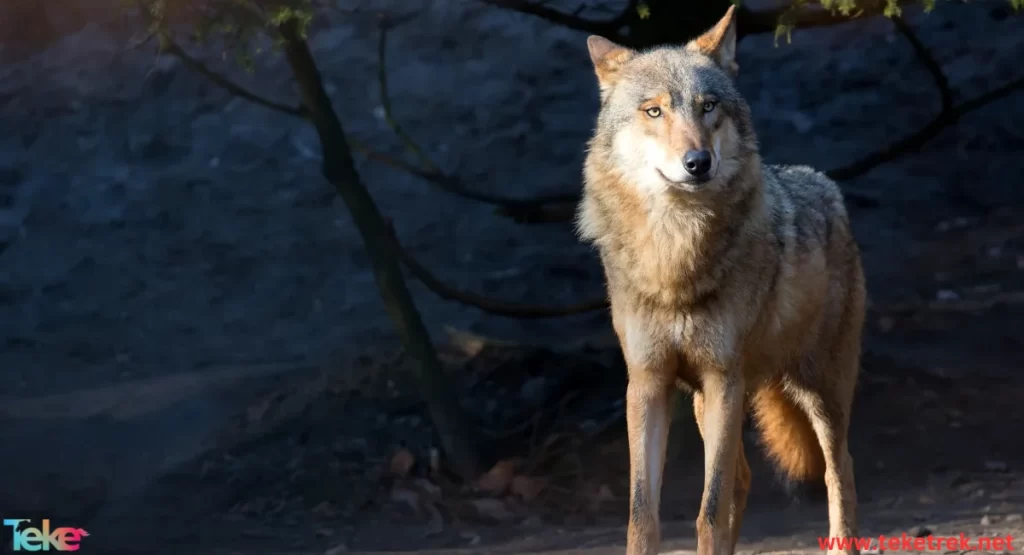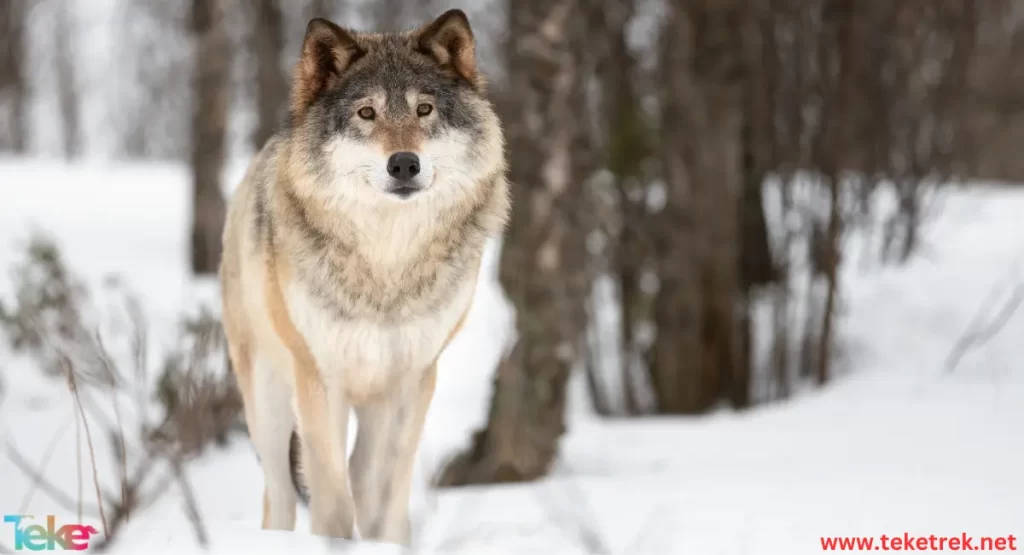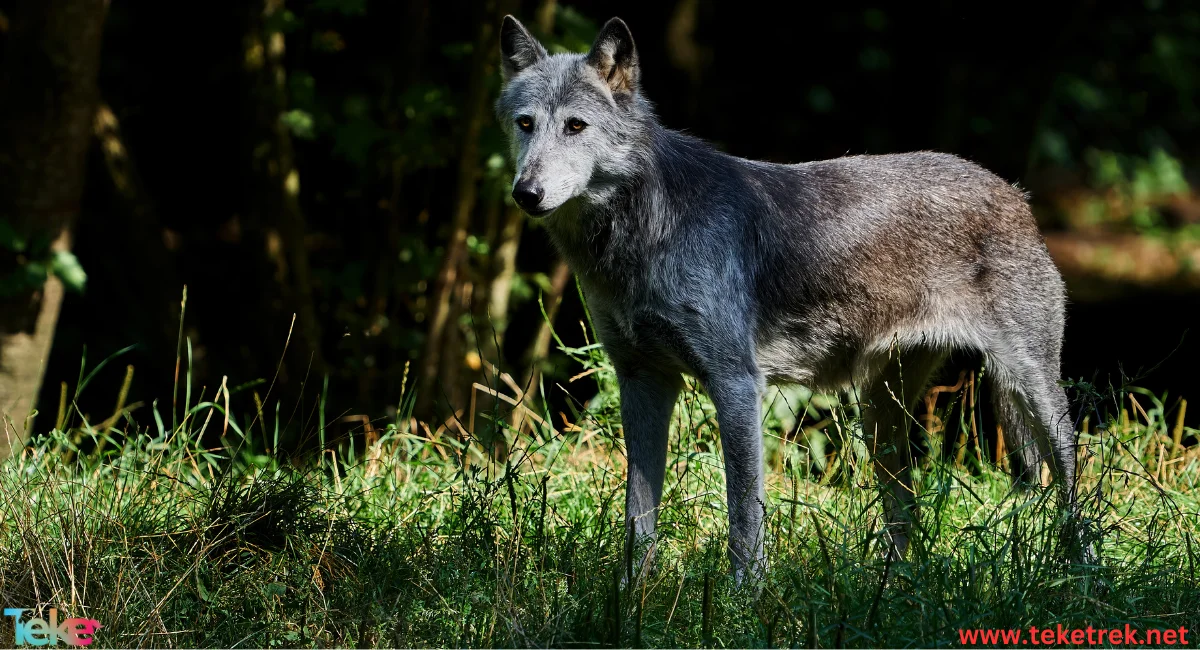The wolve is one of the predatory and mysterious animal, with the ability to adapt and live in various conditions, and it has different species. If you are a fan of the animal world, continue reading this article from Teketrek to learn about one of its most dangerous species.
The wolve meaning and most important information about it
- Wolves inhabit the northern hemisphere, specifically in Europe, Asia, and North America. They often go by the name Gray Wolves due to their widespread distribution as one of the most common species.
- Wolves live in groups and are highly social animals, traveling and hunting in packs of up to 30 members, targeting large herbivores such as moose, bison, deer, and elk as prey.
- Each group is led by a dominant alpha male and female. The male is responsible for guiding the pack on its journeys, while the female is responsible for caring for and defending the pups.
- Dominant pairs mate between February and April, with the female giving birth to up to five or six pups in the spring.
- The weight of male wolves ranges from 30 to 80 kilograms on average, and their length varies between 130 and 205 centimeters. Meanwhile, females weigh between 23 and 55 kilograms and are usually about 20% smaller than males.
- Wolves can live for a long time, with some individuals reaching 10-12 years in the wild and up to 15 years or more in captivity.
- Wolves are keystone species in their ecosystems, meaning they help control the populations of prey species, thus affecting the animals and plants consumed by those species. Due to their ecological importance, conservation and reintroduction projects are ongoing in certain areas where wolf hunting is nearing extinction.

Where do wolves live?
- The Gray Wolf was once the most widespread mammal in the world, but its range today is 30% smaller than it was before.
- Previously, wolves could be found all over the northern hemisphere, but widespread extermination has led to their extinction in most parts of Western Europe, Mexico, and the United States. Wolves have become extinct in some countries, such as Japan.
- Wolves now primarily inhabit remote wilderness areas in the northern hemisphere, especially in Canada, Alaska, Europe, and Asia, thanks to their diverse diet. They prey on animals ranging from moose and wild boars to smaller prey such as hares, and they even scavenge household garbage in urban areas.
- Wolves can live in several different habitats including forests, shrublands, wetlands, grasslands, rocky areas, and deserts.
Physical characteristics and behavior
- The Gray wolve is one of the most widespread species and can appear in a variety of colors, from white to brown to black, but it is often gray.
- The Gray wolve has short, soft fur covered with coarse outer hair. The thick undercoat insulates the wolf from the cold.
- Gray Wolves live in groups typically comprising six to eight individuals. Each wolve has its place within the group and exhibits numerous behaviors that indicate its position in the hierarchical sequence of the pack. For example, the alpha wolf, or dominant male, asserts his dominance by standing tall with his ears erect and forward.
- When an alpha male displays such behavior, lower-ranking wolves will cower, tuck their tails between their legs, and lower their ears. Because each member of the group understands these gestures, fights within the pack occur only rarely. However, strangers may be dealt with harshly within the pack.
- Only alpha male and female wolves breed. The rest of the pack helps protect and feed the alpha female while she nurses her pups.
- Gray Wolves can go a week or more without food, but when a hunting opportunity presents itself, they do not eat recklessly. A single wolve can consume up to nine kilograms of meat in one sitting.
Live in a group
- Wolves care for each other as individuals, forming friendships and tending to their sick and injured. The pack structure facilitates communication, teaching young wolves, and transmitting knowledge across generations.
- A family group can persist for several generations, even decades, carrying knowledge and information over the years, from one generation to another.
- Wolves play together even into old age, raising their young as a group, and caring for their injured companions. When they lose one of their companions, there is evidence that they suffer and mourn that loss.
- Wolves howl to gather the pack or allow other wolves to know their location, and their howls can carry for distances of up to 10 kilometers even in dense forests.
- The pack typically occupies a specific territory and travels along the same routes. When hunting, the group works together, taking turns chasing the prey to exhaust it or splitting up to ambush it.
Are wolves in danger of extinction?
Previously, wolves were classified as endangered due to widespread habitat loss, as settlers converted forests into cities and agricultural pastures. However, the International Union for Conservation of Nature (IUCN) now considers the Gray Wolf a species of least concern, with stable populations since 1996.
What do wolves eat?
Wolves are carnivorous animals, relying on the availability of food. They hunt their prey, scavenge from others, or dig. They hunt large prey such as moose, elk, deer, muskoxen, and bison in groups, and smaller prey like rabbits, rodents, and other small animals individually.
The most famous wolf species and subspecies
- Eurasian Wolf (Canis lupus lupus):
One of several subspecies of the Gray Wolf (Canis lupus) characterizes it by its size and adaptability, with numerous regional variations that slightly differ in size, fur color, and behavior.
- European Wolf (Canis lupus lupus):
Found throughout most of Europe, it is known for its diverse fur color, ranging from white to black, but it is typically gray or brown.
- Siberian Wolf (Canis lupus albus):
Inhabiting Siberia and parts of northern Asia, the animal distinguishes itself with its thick fur and large size, adapting well to the cold environment.
- Indian Wolf (Canis lupus pallipes):
Smaller in size with shorter reddish fur, it adapts to the warmer climate of the Indian subcontinent and the Middle East.


Fun facts about wolves
- Wolves use dens for raising their pups. Dens are sometimes built from abandoned burrows in rock crevices or tree hollows and surrounding areas. These dens can sometimes be quite large with tunnels extending from 2 to 4 meters underground, and some dens have multiple entrances.
- Wolves, diurnal animals, frequently travel long distances, covering ranges of up to 200 kilometers daily. Gray Wolves are recognized for chasing their prey for up to 20 minutes, covering distances of up to 5 kilometers.
- Wolves hunt in packs. They hunt through stealth, harassment, and active pursuit, eventually attacking the hindquarters, flanks, and shoulders of large prey. Most attempts fail.
- The pack usually consists of a mated pair, which are the most dominant animals in the group. Social hierarchy is established and maintained through aggression, intricate postures, and submission.
- Gray Wolves use vocalizations, scent markings, and body language to communicate. They employ howling to convey territorial signals over long distances and to gather the group together when scattered, with each wolf having a distinct howl.
- Despite their reputation as a threat to humans, very few documented wolf attacks on humans exist, and many reported attacks have not resulted in serious injuries.
FAQ
- What are the most important characteristics of a wolf?
The wolf is a deceitful and cunning animal, capable of evasion and many tricks. It is very patient, has a strong sense of smell, and is very patient in general and when hungry in particular. It is very hostile towards humans.
- Is the wolf treacherous or not?
Yes, the wolf is a treacherous animal.
- What is the name of the wolf’s sound?
The sound of a wolf is called air.
- What covers a wolf’s body?
The body of wolves is covered with coarse insulating hair that protects it from water and dirt.
- What does a wolf feed on?
The wolf is a carnivorous animal that feeds on hares, rats, and birds. It may also eat bird eggs and plants.
- Does the wolf live in the desert?
Yes, the wolf is an animal that can live in various environments, including the desert.
In conclusion, there is much talk about wolves as a threat to human life, but the truth is that humans are the ones threatening the lives of wolves. There is a significant debate on this topic. Now that you have learned this information about wolves, what is your opinion? Do they pose a danger to humans or vice versa?






